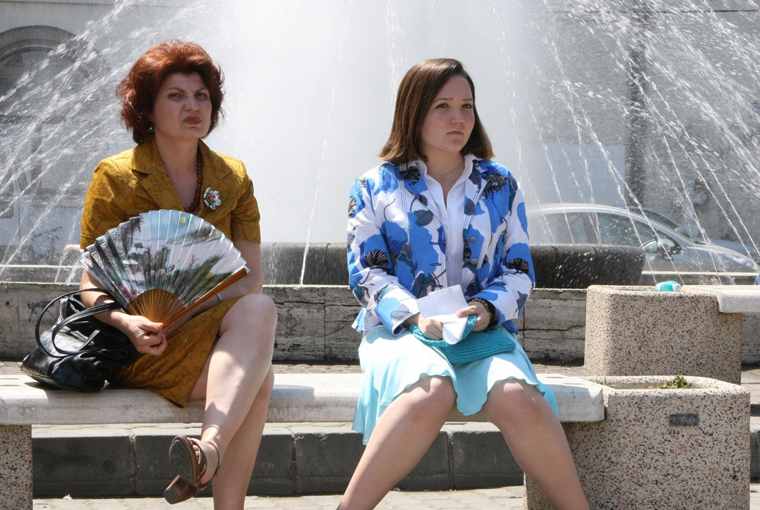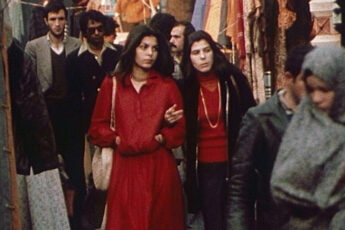New Conditions for Love in Capitalist Romania
Radu Jude’s The Happiest Girl in the World (Cea mai fericită fată din lume, 2009)
Vol. 7 (July 2011) by Ana Ribeiro
I love you, you pay my rent’: the well-known Pet Shop Boy’s song Rent is the opening of the tragicomic story of Delia, a Romanian countryside teenager who is lucky enough – or not – to win a car in a contest sponsored by a fruit juice brand. Radu Jude’s first feature film takes place on the set of the TV commercial of the beverage, in which all the winners are participating, including the shy adolescent. Delia’s luck does not however prevent a feeling of awkwardness from permeating the atmosphere. Whilst she tries to affirm her own will and personality, at the same time these desires appear to be crushed by the greed of her parents.
The Happiest Girl in the World shows how luck can be a relative concept, as indeed is the case of parental love. Delia should be happy with her good fortune in winning a car, and yet the consequences that arise from this piece of luck can actually render her unhappier than she was before. In the first scenes, when she is being taken to the studio for the commercial by her parents in their washed out Dacia, we learn that Delia will hardly have a chance to enjoy her prize, as her mother and father have their own plans for it.
Delia’s journey is one that almost all adolescents take: she is struggling to affirm her own desires and seeks to be treated like an adult. She has an extremely hard time leaving the position of being dominated by her parents: both them and the TV commercial crew place intense pressure on her to act according to their will. The parents force her to sign a document that would allow them to sell the car; they try to convince her to do this with promises that she knows are empty. The TV crew on the other hand, makes her do retake after retake of the same scene. Delia is thus everyone’s puppet, and this is a state of affairs that she seeks to change.
Delia desperately tries to negotiate with her family. She is aware that her signature is essential, and yet the emotional blackmail that she is subjected to pushes her into accepting their ‘terms and conditions’. The TV crew, however, are more difficult to deal with. There is a lack of intimacy with the professionals, the camera and the set as a whole fosters a strangeness and helplessness in Delia. In this situation she has to collaborate as, after all, the company that requested the commercial is the one giving her the prize. Thus, in this case, negotiation is not an option. Faced with her own powerlessness, Delia provides some small signs of rebellion: when it appears that she is finally giving in to her parents, she finds a way of walking out – although her refusal is never a definitive one. Whilst she cannot dispute the orders of those in charge of the TV commercial, she walks out of the set saying that she’s going to the bathroom. Finally, we learn that, outside of her parent’s supervision, she smokes.
The film is based on repetitions: Delia’s parents constantly insist that she signs the papers allowing them to sell the car, and she has to repeat the lines and gestures of her part in the commercial so many times that it seems to border on the realms of insanity. Jude cleverly uses this method in his mise-en-abîme – having a wide experience in advertising, he translates this into the exhausting repetition of scenes that is common on commercial sets, especially when one deals with amateur ‘actors’. The Happiest Girl in the World escapes the advertising features that one often finds in films by directors with similar backgrounds to Jude’s. Indeed, the editing avoids making the narrative too fast-paced.
The repetitions allow the audience to place themselves in Delia’s perspective, so that they can understand why the girl seems so burnt out. The film is marked by its simplicity, a feature that seems to define the works of the so-called Romanian New Wave. There are few locations, the camera movements are minimal, and the art itself is frugal: the force of the film resides in the dialogue and the mise-en-scène, where repetition plays such a crucial part.
The use of the mise-en-abîme is a similarity with yet another Romanian New Wave film, Corneliu Porumboiu’s 12.08 East of Bucharest (2006). In this case, there is a whole TV set in the film. We can thus see that both Jude and Porumboiu, in their respective films, are questioning the use of fiction. If the latter’s film refers directly to the manipulated imagery of the revolution that put an end to communism in Romania, the former’s concentrates on the way that fiction is engendered in feelings. The emotional blackmail orchestrated by Delia’s parents shows us how love can be a construction, and that even parental love – which many consider unconditional – may sometimes only exist under certain circumstances. Their love is conditional on Delia giving up her car – she, if she loves them, needs to hand them her prize as they ‘pay her rent’. In such a situation, Delia’s happiness – that she is pushed to show in the TV commercial – is the one typical of advertising: fake.
In this sense, Delia’s journey is also a metaphor for contemporary capitalist Romania, a country that struggles to be completely admitted in the New Europe – just as the girl has to struggle to show that she deserves to be accepted in the adult world. Her fictional happiness is the same that one would expect of a relatively poor country entering a new sphere where it shares supposedly similar opportunities with its richer neighbors. The Happiest Girl in the World is therefore a tale of refined irony that is evidenced by the title itself, and demonstrates that maybe love and happiness can only exist under certain conditions in contemporary Romania.




Leave a Comment